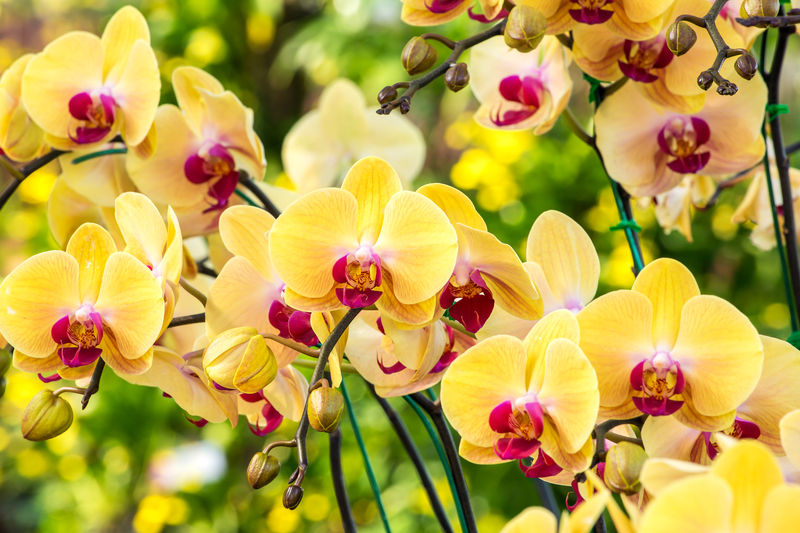Maintaining Garden Color All Year
Posted on 22/09/2024
Maintaining garden color all year can transform your outdoor space into a vibrant oasis, no matter the season. Achieving this continuous burst of color requires careful planning, plant selection, and ongoing garden care. In this article, we will explore various techniques and tips to help you create a garden that brims with color throughout the year.

Understanding Your Climate
Before you start planting, it's crucial to understand the climatic conditions of your region. Different plants thrive in different climates, and knowing your hardiness zone will help you choose the right plants that can survive and flourish through the changing seasons. Check the USDA Plant Hardiness Zone Map to determine your zone.
Choosing the Right Plants
Selecting plants with varying blooming periods is vital for year-round color. Here are some plant suggestions by season:
- Spring: Tulips, daffodils, and peonies are great for spring. Their vibrant colors will kickstart your garden's yearly journey.
- Summer: Consider planting marigolds, zinnias, and hibiscus. These florals thrive in the heat and provide lush summer color.
- Autumn: Chrysanthemums, asters, and ornamental kale can add rich hues as the weather cools.
- Winter: Holly, winter jasmine, and hellebores are perfect for adding a splash of color in the colder months. Evergreens also play a crucial role during this period.
Incorporating Evergreens and Foliage
Evergreens are essential for providing a consistent backdrop of green throughout the year. Incorporate a mix of evergreen trees, shrubs, and ground covers into your garden design. Additionally, don't underestimate the power of foliage. Plants like hostas, heucheras, and ferns offer striking leaf colors and patterns that can be just as captivating as flowers.
Using Perennials and Annuals
A balanced mix of perennials and annuals will ensure a continuous display of color. Perennials return each year and can provide a reliable base of greenery and blooms. Annuals, on the other hand, offer a burst of color for a single growing season. By carefully choosing and rotating annuals, you can fill any gaps left by perennials.
Mulching and Soil Care
Healthy soil is the foundation of a vibrant garden. Regularly mulching your garden beds helps retain moisture, suppress weeds, and improve soil quality. Consider organic mulches like compost, leaf mold, or wood chips. Additionally, conduct soil tests periodically to monitor pH levels and nutrient content. Amend the soil as needed to provide optimal growing conditions for your plants.
Regular Maintenance
Keeping your garden looking vibrant year-round involves regular maintenance. Deadheading spent flowers encourages new blooms, while pruning helps shape plants and remove dead or diseased parts. Monitor for pests and diseases, and address any issues promptly to prevent them from spreading. Watering is also critical; ensure plants receive sufficient water, especially during dry spells.
Creative Use of Containers
Container gardening allows for greater flexibility and mobility. You can use containers to add seasonal color to patios, decks, and entryways. Choose containers of various sizes and materials to create visual interest. Additionally, you can easily replace the plants in containers as the seasons change, ensuring a continuous display of fresh blooms.
Pros and Cons of Maintaining Year-Round Garden Color
Pros:
- Aesthetic Appeal: A colorful garden enhances the visual appeal of your outdoor space throughout the year.
- Biodiversity: Diverse plant selection attracts various pollinators and wildlife, promoting a healthy ecosystem.
- Mental Well-being: Gardening and being surrounded by nature can reduce stress and improve mental health.
Cons:
- Time-Consuming: Maintaining a colorful garden requires ongoing effort, time, and commitment.
- Cost: The initial setup and seasonal planting can be costly, especially when purchasing new plants and garden supplies.
- Pest and Disease Management: Continuous monitoring and management of pests and diseases are necessary to keep plants healthy.
Tips for Maintaining Year-Round Garden Color
1. Plan your garden layout with seasonal color in mind.
2. Choose native plants that are well-adapted to your climate.
3. Rotate annuals to fill gaps between perennial bloom periods.
4. Incorporate plants with colorful foliage and bark for winter interest.
5. Use containers to experiment with different plant combinations.
6. Regularly mulch and amend the soil for optimal plant health.
7. Stay vigilant about pests and diseases, and address issues promptly.

Takeaways
1. Understanding your climate is crucial for plant selection and garden planning.
2. A diverse mix of plants, including evergreens, perennials, annuals, and container plants, ensures year-round color.
3. Regular maintenance, including mulching, pruning, and pest management, is essential for a thriving garden.
4. There are both benefits and challenges to maintaining a colorful garden year-round, requiring consideration of aesthetic, time, cost, and effort factors.
Conclusion
Maintaining garden color all year is a rewarding endeavor that brings beauty, biodiversity, and personal satisfaction. By understanding your climate, choosing the right plants, and committing to regular garden care, you can create a vibrant and dynamic outdoor space that captivates and enchants throughout every season. Happy gardening!




